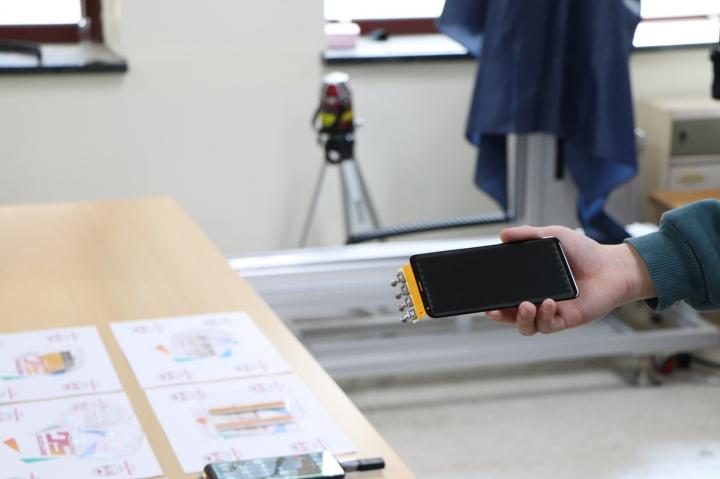A step closer to future 5G smartphones with the world's first Antenna-on-Display

This is the world's first Antenna-on-Display. Credit: POSTECH
It has been few years since physical key boards have been replaced by on-screen touch sensors for wireless devices such as cellular phones. This even-tually triggered the modern day smartphone-era by introducing large-screen displays on portable devices.
In which country was this technology first in-troduced? The answer is Republic of Korea. This time, an innovative 5G smartphone with optically invisible antennas that are embedded within super-resolution displays will be introduced to the market for the first time in the world – again from Korea.
On the 27th of March, a University-Industry research consortium lead by Pohang University of Science and Technology (POSTECH) and joined by industry partners such as Dong-Woo Fine Chem, SK Telecom, LG Electronics, Keysight Technologies, and Y.Tech announced the world's first 'Antenna-on-Display (AoD)' technology. Spearheaded by POSTECH Professor Wonbin Hong's re-search team, this was the first multilateral academia-industry research cooperation in Korea.
The POSTECH research consortium has successfully completed field testing of this technology on a 28 GHz 5G Android smartphone platform and they expect this to expedite the deployment of new concepts for 5G devices in the near future.
5G is expected to be at least 20 times faster than the speed of 4G LTE. Among multiple wireless components, the antenna is one of the most critical differentiators that enable such technology jump. 5G relies on millimeter-wave frequencies which are at least an order of magnitude higher than cur-rent 4G LTE and Wi-Fi. Consequently, the signal attenuation at millimeter-wave becomes much greater, leading to the need to “clustering of the antennas” to form a dense electromagnetic beam at certain directions similar to how microscopes work. Naturally, this means 5G wireless devices requires dozens of antenna in contrast to single-digit number of antennas during the 4G era.
However, in the mobile industry, the lack of space to place the 5G antennas within cellular devices has been the fundamental challenge. Future smartphones are expected to be ergonomically, esthetically and technically advanced-simultaneously. Using conventional antenna technology, more number of antennas to support 5G implies an undesired trade-off situation. Naturally this paradox has been slowing down the worldwide deployment of 5G cellular devices up to present.
Professor Wonbin Hong of POSTECH and his research team developed an alternative that can embed antennas directly on a display and exemplified its possibility of commercialization in the future. This technology is fundamentally different from conventional antenna for cellular devices. Denoted as Antenna-on-Display (AoD), this concept enables an antenna that is de-signed using nano-scale fabrication technology to trick the human eye into thinking that the antenna is invisible.
Using this technology, it is now possible to co-use the entire view area of high definition displays such as OLED and LCD for massive number of 5G antennas. This eliminates the trade-off relation between ergonomics, esthetics and technology. The research team developed a transparent thin film with Dong-Woo Fine Chem for the AoD. LG Electronics integrated the AoD within their cellular device prototype and this was used to conduct real-life 5G trials at 28 GHz with SK Telecom. This research is significant in demonstrating multilateral academia-industry cooperation for the first time in the nation. The research is published on IEEE Transactions on Antennas and Propagation, one of the leading journals in the field of electronics and electric engineering.
Professor Wonbin Hong of POSTECH who led the research explained, “this is the first step of our collaborative research. Similar to how on-screen touch sensors redefined wireless devices, the Antenna-on-Display has the potential to trigger various possibilities for 5G and beyond. We expect it will contribute not only to creating innovative 5G smartphone concepts but serving as an enabling technology for many ideas beyond our imagination”
Mr. Jong Kwan Park, Director of 5GX Labs at SK Telecom said, “SK Telecom will continue to collaborate with POSTECH research consortium to provide the world's leading 5G services related innovations.”
###
This research was partially supported by the Institute of Information and Communications Technology Planning and Evaluation which is an affiliated organization of Ministry of Science and ICT.
Media Contact
Hyeyong Choi
canary@postech.ac.kr
82-542-792-413
Media Contact
More Information:
http://dx.doi.org/10.1109/TAP.2019.2900399All latest news from the category: Information Technology
Here you can find a summary of innovations in the fields of information and data processing and up-to-date developments on IT equipment and hardware.
This area covers topics such as IT services, IT architectures, IT management and telecommunications.
Newest articles

NASA: Mystery of life’s handedness deepens
The mystery of why life uses molecules with specific orientations has deepened with a NASA-funded discovery that RNA — a key molecule thought to have potentially held the instructions for…

What are the effects of historic lithium mining on water quality?
Study reveals low levels of common contaminants but high levels of other elements in waters associated with an abandoned lithium mine. Lithium ore and mining waste from a historic lithium…

Quantum-inspired design boosts efficiency of heat-to-electricity conversion
Rice engineers take unconventional route to improving thermophotovoltaic systems. Researchers at Rice University have found a new way to improve a key element of thermophotovoltaic (TPV) systems, which convert heat…



